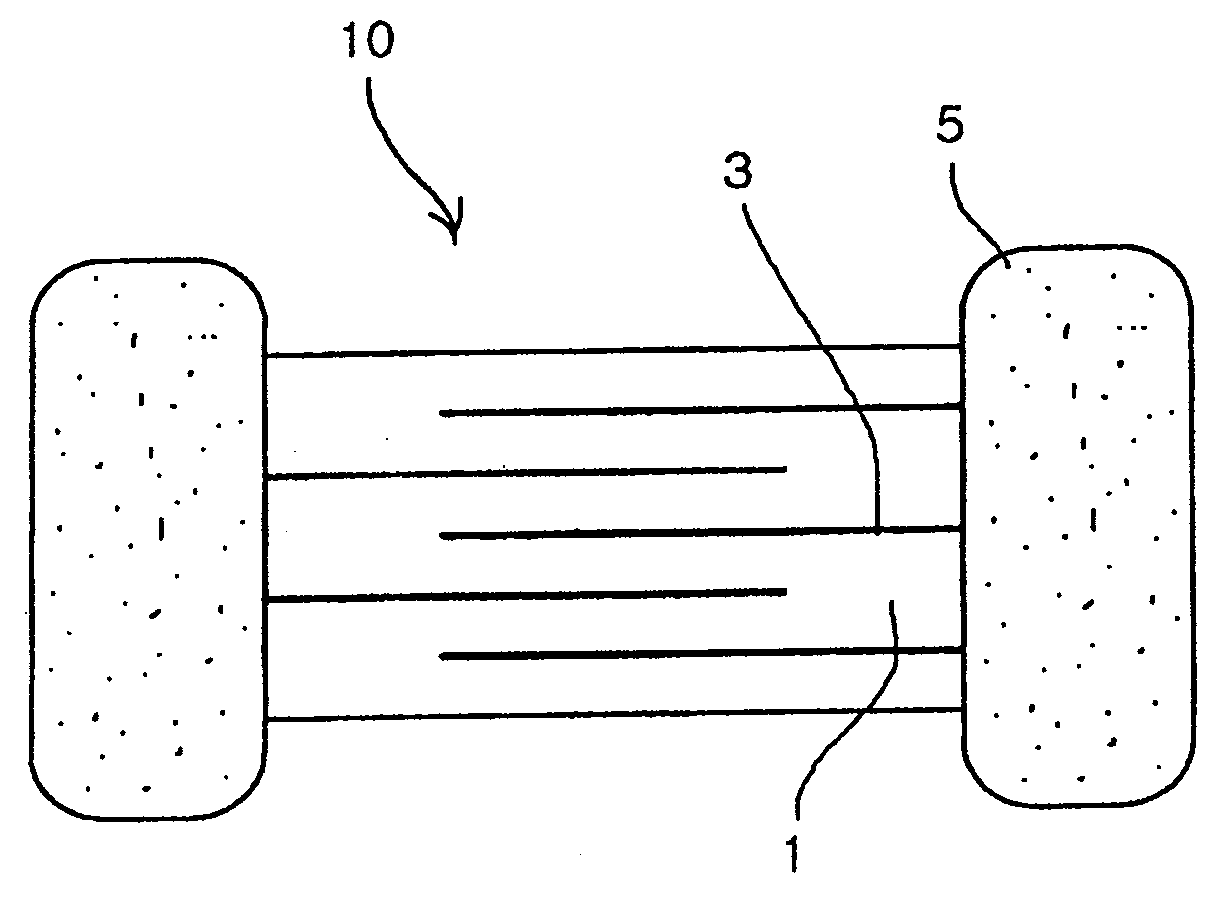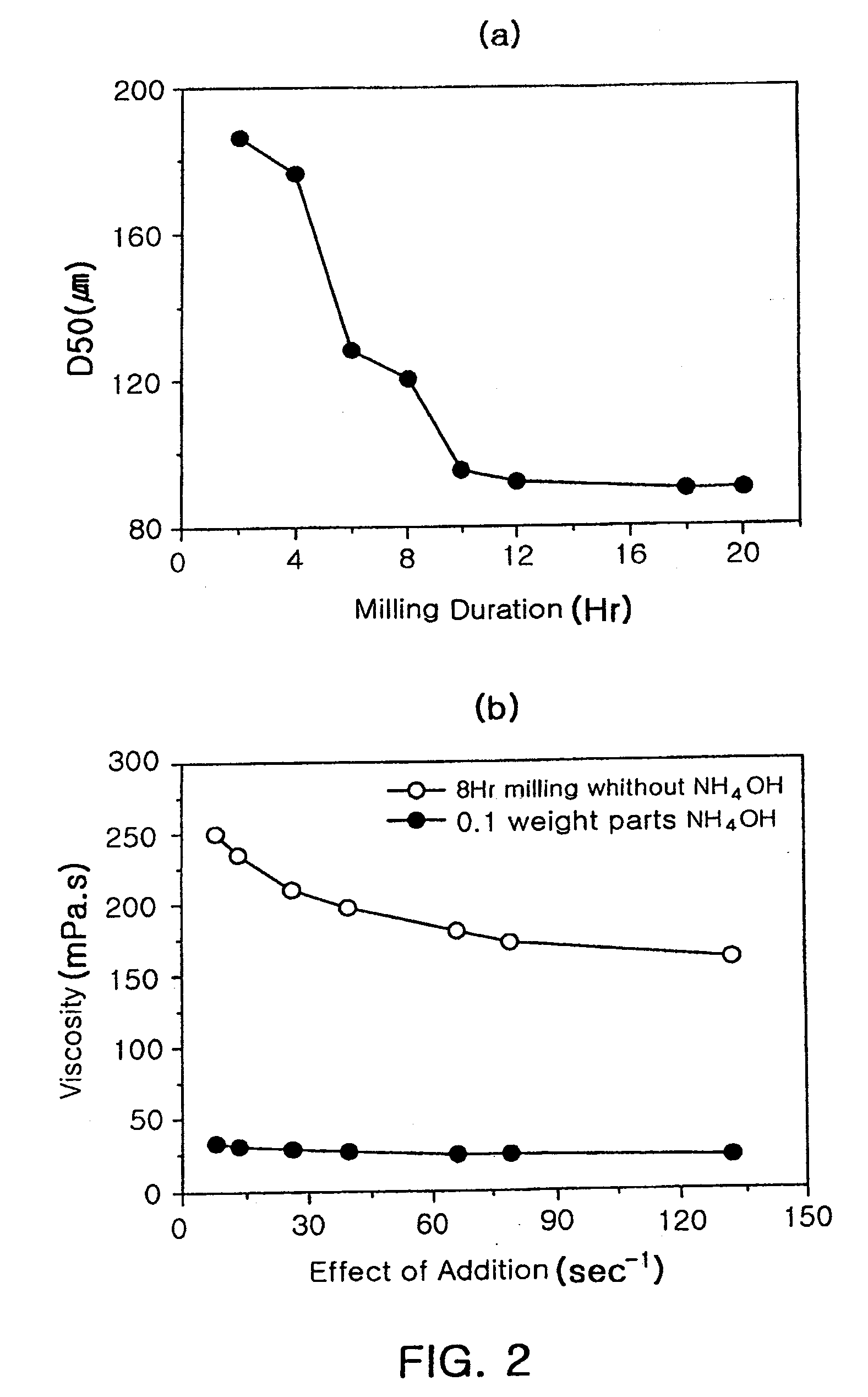Method for manufacturing dielectric ceramic powder, and multilayer ceramic capacitor obtained by using the ceramic powder
a technology of ceramic powder and multilayer capacitor, which is applied in the direction of fixed capacitor details, fixed capacitors, printing, etc., can solve the problems of deterioration of batiosub>3/sub>powder properties, difficult design and maintenance of a reactor, and high manufacturing cost, and achieve uniform particle size distribution and high tetragonal crystalinity
- Summary
- Abstract
- Description
- Claims
- Application Information
AI Technical Summary
Benefits of technology
Problems solved by technology
Method used
Image
Examples
example 1
[0070]BaCO3 raw powder having a specific surface area of20 m2 / g was prepared. Some of BaCO3 raw powder was dispersed into a mixed solution of distilled water and polyacrylic dispersant to manufacture BaCO3 slurry. BaCO3 raw powder was dispersed into the solution to such an extent that the BaCO3 slurry would contain 10 to 60wt % BaCO3 The slurry was wet-milled for 18 hours via beads mill type equipment that uses zirconia beads with a diameter of 0.3 mm as milling media. During wet-milling, considering a sudden increase in viscosity in accordance with decrease in BaCO3 particle numbers, ammonia was added after 8 hour milling to reduce viscosity. A specific surface area of the wet-milled BaCO3 powder was 31 m2 / g, a significant increase from the initial one, and the particles had almost a spherical shape.
[0071]Field Emission (FE-SEM) picture before and after wet-milling BaCO3 is shown in FIG. 4(a-b). As shown in the aforesaid FIG. 4(a-b), wet-milling changed BaCO3 from acicular powder i...
example 2
[0075]
TABLE 1Specific surface areaWet-milling of(m2 / g)CalcinationNo.BaCO3BaCO3TiO2CaCO3temp. (° C.)1Not wet-milled202010202Not wet-milled202010403Wet-milled312010204Wet-milled312010405Wet-milled31459606Wet-milled31459907Wet-milled314510208Wet-milled3145309609Wet-milled314530990
[0076]BaCO3 raw powder having a specific surface area of 20 m2 / g was prepared. Some of BaCO3 raw powder was dispersed into a mixed solution of distilled water and polyarcrylic dispersant to produce BaCO3 slurry. BaCO3 powder was dispersed into the solution to such an extent that BaCO3 slurry would contain 10 to 60 wt % BaCO3. The resultant slurry was wet milled for 18 hours via beads mill type equipment using zirconia beads with a diameter of 0.3 mm as milling media. Considering a sudden increase in viscosity in accordance with decrease in BaCO3 particle numbers during a wet-milling process, ammonia was added to reduce viscosity after 8-hour milling. A specific surface area of the wet-milled BaCO3 powder is sh...
PUM
| Property | Measurement | Unit |
|---|---|---|
| particle size | aaaaa | aaaaa |
| BET specific surface area | aaaaa | aaaaa |
| temperature | aaaaa | aaaaa |
Abstract
Description
Claims
Application Information
 Login to View More
Login to View More - R&D
- Intellectual Property
- Life Sciences
- Materials
- Tech Scout
- Unparalleled Data Quality
- Higher Quality Content
- 60% Fewer Hallucinations
Browse by: Latest US Patents, China's latest patents, Technical Efficacy Thesaurus, Application Domain, Technology Topic, Popular Technical Reports.
© 2025 PatSnap. All rights reserved.Legal|Privacy policy|Modern Slavery Act Transparency Statement|Sitemap|About US| Contact US: help@patsnap.com



